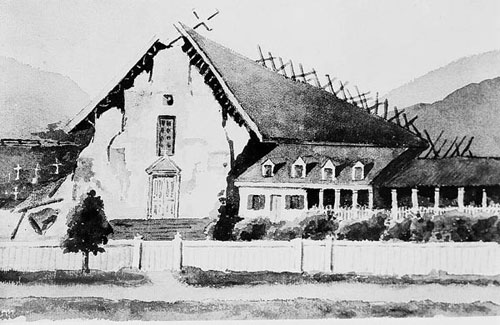
Contemporary image of Mission San Jose following its collapse in the 1868 earthquake.
Here's a thought I had about the deposition at our site, while writing up my analysis section of the site report. Suppose instead of being deposited here in order to building something on top of it, our large area of apparently secondary materials was actually rubble moved here just to clear away somewhere else that someone did want to build/plant on? It would explain why, aside from the road, we haven't found any structures or obvious signs of viticulture such as actual vines, trellises, or other grape-related paraphrenelia. Burning a trash heap is also something people do. Here is the relevant section of my report, with the connection to my own unit:
It is possible that refuse has been dumped on our site area from the mission period onward, but that seems unlikely given its uphill location from the mission settlement. More likely, all of the material, mission, rancho and all, was moved at some point as a whole mass. It is worth considering the fact that we do know for certain, that there was much and sometimes rapid land exchange during the period following secularization, and again following the Gold Rush era. It is also poignant that so little explicitly agricultural has emerged, given the centrality the question of the vineyard has had in some of the proposed hypotheses for this site. I think it is worth considering a hypothesis that I have not yet heard anyone advance, that this midden already existed somewhere down the hill when a land exchange put it in the hands of a new owner, who rather than wanting it to build up a terrace or roadbed, simply wanted it out of their way. Our site may not be the result an attempt to conduct agricultural activities here on Site DSCQHR, but merely an attempt to clear away some old middens or earthquake rubble in order to make some space for agricultural activities somewhere else. Our site may have had value simply as an unused field, as indeed it still is, somewhere a new owner of more valuable agricultural land elsewhere could dump an old trash heap without it being in anyone's way. Nevertheless, this suggestion is also based more on absence of evidence than evidence, and lacks any secondary historical sources to back it up.
According any of the interpretations so far advanced, U3 can be understood as further evidence of this unknown refuse/fill deposition process, and I think the more productive burnt area, especially considering the number of burnt bone and glass, probably represents kitchen refuse. I do not now believe that a feature exists in the unit in the sense of something having purposefully placed there as its original depositional environment, given the lack of any clearly defined boundaries, stratigraphic markers, or widespread regular patterns in artifact distribution beyond certain artifact type clusters and scatters.
This is really interesting and a little depressing considering we've been speculating that we've been digging up an old orchard or vineyard or something like that. It does explain why there is so much burnt stuff and why the road might be there. Good information and thanks for sharing.
ReplyDeleteOh, there's nothing depressing about a garbage pile. Bread and butter of the archaeologist, after all. And middens can be more "honest" than a lot of other sources of information!
ReplyDeleteVery well articulated Andrew. I find this perceptive:
ReplyDelete"Suppose instead of being deposited here in order to building something on top of it, our large area of apparently secondary materials was actually rubble moved here just to clear away somewhere else that someone did want to build/plant on? It would explain why, aside from the road, we haven't found any structures or obvious signs of viticulture such as actual vines, trellises, or other grape-related paraphernalia."(Hayes, 2011)
The idea that one of the artifact layers represents a secondary deposit is very attractive.
Cheers! David P.
Did you class have anything to go on, on a historical content level? In other words, did you have any information given you that two homes had been on that bit of acreage/lot? I grew up on Telles Lane, (just one road over going west) and your dig area was the backyard to two homes that I know of. One was the Gallegos Estate.
ReplyDelete